List of natural satellites
 |
| Objects |
|---|
| Lists |
|
|
The Solar System's planets and officially recognised dwarf planets are known to be orbited by 182 natural satellites, or moons. 19 moons in the Solar System are large enough to be gravitationally rounded, and thus would be considered planets or dwarf planets if they were in direct orbit around the Sun.
Moons are classed in two separate categories according to their orbits: regular moons, which have prograde orbits (they orbit in the direction of their planets' rotation) and lie close to the plane of their equators, and irregular moons, whose orbits can be pro- or retrograde (against the direction of their planets' rotation) and often lie at extreme angles to their planets' equators. Irregular moons are probably minor planets that have been captured from surrounding space. Most irregular moons are less than 10 kilometres (6.2 mi) in diameter.
The earliest published discovery of a moon other than the Earth's was by Galileo Galilei, who discovered the four Galilean moons orbiting Jupiter in 1610. Over the following three centuries only a few more moons were discovered. Missions to other planets in the 1970s, most notably the Voyager 1 and 2 missions, saw a surge in the number of moons detected, and observations since the year 2000, using mostly large ground-based optical telescopes, have discovered many more, all of which are irregular.
Moons by primary



Mercury, the smallest and innermost planet, has no moons, or at least none that can be detected to a diameter of 1.6 km (1.0 mi).[1] For a very short time in 1974, Mercury was thought to have a moon.
Venus also has no moons,[2] though reports of a moon around Venus have circulated since the 17th century.
Earth has one Moon, the largest moon of any rocky planet in the Solar System. Earth also has at least two co-orbitals: the asteroids 3753 Cruithne and 2002 AA29;[3] however, since they do not orbit Earth, they are not considered moons. (See Other moons of Earth and Quasi-satellite.)
Mars has two known moons, Phobos and Deimos ("fear" and "dread", after attendants of Ares, the Greek god of war, equivalent to the Roman Mars). Searches for more satellites have been unsuccessful, putting the maximum radius of any other satellites at 90 m (100 yd).[4]
Jupiter has 67 known moons with confirmed orbits. Its eight regular moons are grouped into the planet-sized Galilean moons and the far smaller Amalthea group. They are named after lovers of Zeus, the Greek equivalent of Jupiter. Its 59 known irregular moons are organized into two categories: prograde and retrograde. The prograde satellites consist of the Himalia group and two others in groups of one. The retrograde moons are grouped into the Carme, Ananke and Pasiphae groups, as well as some isolated moons.
Saturn has 62 moons with confirmed orbits, 53 of which have names, most of which are quite small. Seven moons are large enough to be in hydrostatic equilibrium, including Titan, the second largest moon in the Solar System. Twenty-four of Saturn's moons are regular, and traditionally named after Titans or other figures associated with the mythological Saturn. The remaining thirty-eight, all small, are irregular, and classified by their orbital characteristics into Inuit, Norse, and Gallic groups, and their names are chosen from the corresponding mythologies. The rings of Saturn are made up of icy objects ranging in size from one centimetre to hundreds of metres, each of which is on its own orbit about the planet. Thus a precise number of Saturnian moons cannot be given, as there is no objective boundary between the countless small anonymous objects that form Saturn's ring system and the larger objects that have been named as moons. At least 150 "moonlets" embedded in the rings have been detected by the disturbance they create in the surrounding ring material, though this is thought to be only a small sample of the total population of such objects.
Uranus has 27 named moons, five of which are massive enough to have achieved hydrostatic equilibrium. There are another 13 inner moons that orbit within Uranus's ring system, and another nine outer irregular moons. Unlike most planetary moons, which are named from antiquity, all the moons of Uranus are named after characters from the works of Shakespeare and Alexander Pope's work The Rape of the Lock.
Neptune has 14 moons (one of which is unnamed); the largest, Triton, accounts for more than 99.5 percent of all the mass orbiting the planet. Triton is large enough to have achieved hydrostatic equilibrium, but, uniquely for a large moon, has a retrograde orbit, suggesting it was captured. Neptune also has six known inner regular satellites, and six outer irregular satellites.
The dwarf planet Pluto has five moons. Its largest moon Charon, named after the ferryman who took souls across the River Styx, is more than half as large as Pluto itself, and large enough to orbit a point outside Pluto's surface. In effect, each orbits the other, forming a binary system informally referred to as a double-dwarf-planet. Pluto's four other moons, Nix, Hydra, Kerberos and Styx are far smaller and orbit the Pluto–Charon system.
Among the other dwarf planets, Ceres has no known moons. It is 90 percent certain that Ceres has no moons larger than 1 km in size, assuming that they would have the same albedo as Ceres itself.[5] Haumea has two moons, Hi'iaka and Namaka, of radii ~195 and ~100 km, respectively.[6] Makemake has one moon, discovered in April 2016. A satellite having 1% Makemake's brightness would have been detected if it had been located at an angular distance from Makemake farther than 0.4 arcseconds (0.0001 degrees).[7] Eris has one known moon, Dysnomia. Accurately determining its size is difficult: one indicative estimate of its radius is 257±110 km,[8] but on some assumptions could be as high as 342±25 km.[9] The Kuiper belt object 90482 Orcus, believed to be a dwarf planet, was found in 2005[10] to have a natural satellite, later named Vanth. As of October 2009, 190 asteroid moons[11] and 63 trans-Neptunian moons had been discovered.[11]
-
Summary – number of moons Planet Mercury Venus Earth Mars Jupiter Saturn Uranus Neptune Number of moons 0 0 1 2 67 62 27 14 -
Dwarf planet Ceres Pluto Haumea Makemake Eris Number of moons 0 5 2 1 1
List
This is a list of the recognized moons of the planets and of the largest dwarf planets of the Solar System. The 19 moons that are large enough to have been rounded by their own gravity are listed in bold. The seven largest moons, which are larger than any of the known dwarf planets, are listed in bold and italic. Sidereal period differs from semi-major axis because it depends on the mass of the primary as well as the satellite's distance from it.
| Satellite of Earth | Satellites of Saturn | Satellites of Pluto |
| Satellites of Mars | Satellites of Uranus | Satellites of Haumea |
| Satellites of Jupiter | Satellites of Neptune | Satellite of Eris |
| Satellite of Makemake |
| Image | Numeral | Name | Mean radius (km) | Semi-major axis (km) | Sidereal period (d) (r = retrograde) |
Discovery year | Discovered by | Notes | Ref(s) | Planet |
|---|---|---|---|---|---|---|---|---|---|---|
| | I | Moon | 1737.10 | 384,399 | 27.321582 | Prehistoric | — | Synchronous rotation | [12] | Earth |
| | I | Phobos | 11.1 ± 0.15 | 9,380 | 0.319 | 1877 | Hall | [13][14][15] | Mars | |
 | II | Deimos | 6.2 ± 0.18 | 23,460 | 1.262 | 1877 | Hall | [13][14][15] | Mars | |
 | I | Io | 1818.1 ± 0.1 | 421,800 | 1.769 | 1610 | Galileo | Main-group moon (Galilean) | [15][16] | Jupiter |
 | II | Europa | 1560.7 ± 0.7 | 671,100 | 3.551 | 1610 | Galileo | Main-group moon (Galilean) | [15][16] | Jupiter |
 | III | Ganymede | 2634.1 ± 0.3 | 1,070,400 | 7.155 | 1610 | Galileo | Main-group moon (Galilean) | [15][16] | Jupiter |
 | IV | Callisto | 2408.4 ± 0.3 | 1,882,700 | 16.69 | 1610 | Galileo | Main-group moon (Galilean) | [15][16] | Jupiter |
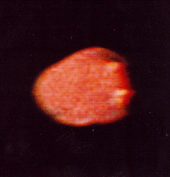 | V | Amalthea | 83.45 ± 2.4 | 181,400 | 0.498 | 1892 | Barnard | Inner moon (Amalthea) | [14][15][17] | Jupiter |
| | VI | Himalia | 67 ± 10[18] | 11,461,000 | 250.56 | 1904 | Perrine | Prograde irregular (Himalia) | [14][15][19] | Jupiter |
 | VII | Elara | 43 | 11,741,000 | 259.64 | 1905 | Perrine | Prograde irregular (Himalia) | [14][15][20] | Jupiter |
| | VIII | Pasiphae | 30 | 23,624,000 | 743.63 (r) | 1908 | Melotte | Retrograde irregular (Pasiphae) | [14][15][21] | Jupiter |
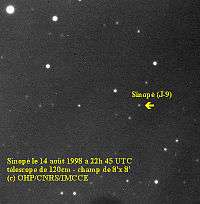 | IX | Sinope | 19 | 23,939,000 | 758.90 (r) | 1914 | Nicholson | Retrograde irregular (Pasiphae) | [14][15][22] | Jupiter |
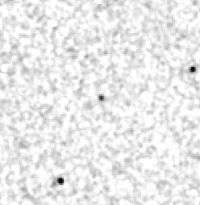 | X | Lysithea | 18 | 11,717,000 | 259.20 | 1938 | Nicholson | Prograde irregular (Himalia) | [14][15][23] | Jupiter |
 | XI | Carme | 23 | 23,404,000 | 734.17 (r) | 1938 | Nicholson | Retrograde irregular (Carme) | [14][15][23] | Jupiter |
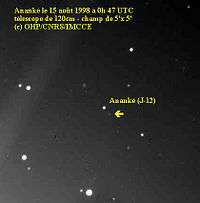 | XII | Ananke | 14 | 21,276,000 | 629.77 (r) | 1951 | Nicholson | Retrograde irregular (Ananke) | [14][15][24] | Jupiter |
| XIII | Leda | 10 | 11,165,000 | 240.92 | 1974 | Kowal | Prograde irregular (Himalia) | [14][15][25] | Jupiter | |
 | XIV | Thebe | 49.3 ± 2.0 | 221,900 | 0.675 | 1979 | Synnott (Voyager 1) | Inner moon (Amalthea) | [14][15][26] | Jupiter |
| | XV | Adrastea | 8.2 ± 2.0 | 129,000 | 0.298 | 1979 | Jewitt, Danielson (Voyager 1) | Inner moon (Amalthea) | [14][15][27] | Jupiter |
| | XVI | Metis | 21.5 ± 2.0 | 128,000 | 0.295 | 1979 | Synnott (Voyager 1) | Inner moon (Amalthea) | [14][15][28] | Jupiter |
| | XVII | Callirrhoe | 4.3 | 24,103,000 | 758.77 (r) | 2000 | Scotti, Spahr, McMillan, Larsen, Montani, Gleason, Gehrels | Retrograde irregular (Pasiphae) | [14][15][29] | Jupiter |
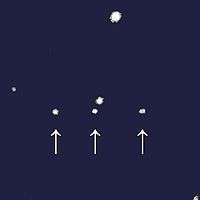 | XVIII | Themisto | 4.0 | 7,284,000 | 130.02 | 1975/2000 | Kowal and Roemer (original); Sheppard, Jewitt, Fernández, Magnier (rediscovery) | Prograde irregular (Themisto) | [14][15][30][31] | Jupiter |
| XIX | Megaclite | 2.7 | 23,493,000 | 752.86 (r) | 2000 | Sheppard, Jewitt, Fernández, Magnier, Dahm, Evans | Retrograde irregular (Pasiphae) | [14][15][32] | Jupiter | |
| XX | Taygete | 2.5 | 23,280,000 | 732.41 (r) | 2000 | Sheppard, Jewitt, Fernández, Magnier, Dahm, Evans | Retrograde irregular (Carme) | [14][15][32] | Jupiter | |
| XXI | Chaldene | 1.9 | 23,100,000 | 723.72 (r) | 2000 | Sheppard, Jewitt, Fernández, Magnier, Dahm, Evans | Retrograde irregular (Carme) | [14][15][32] | Jupiter | |
| XXII | Harpalyke | 2.2 | 20,858,000 | 623.32 (r) | 2000 | Sheppard, Jewitt, Fernández, Magnier, Dahm, Evans | Retrograde irregular (Ananke) | [14][15][32] | Jupiter | |
| XXIII | Kalyke | 2.6 | 23,483,000 | 742.06 (r) | 2000 | Sheppard, Jewitt, Fernández, Magnier, Dahm, Evans | Retrograde irregular (Carme) | [14][15][32] | Jupiter | |
| XXIV | Iocaste | 2.6 | 21,060,000 | 631.60 (r) | 2000 | Sheppard, Jewitt, Fernández, Magnier, Dahm, Evans | Retrograde irregular (Ananke) | [14][15][32] | Jupiter | |
| XXV | Erinome | 1.6 | 23,196,000 | 728.46 (r) | 2000 | Sheppard, Jewitt, Fernández, Magnier, Dahm, Evans | Retrograde irregular (Carme) | [14][15][32] | Jupiter | |
| XXVI | Isonoe | 1.9 | 23,155,000 | 726.23 (r) | 2000 | Sheppard, Jewitt, Fernández, Magnier, Dahm, Evans | Retrograde irregular (Carme) | [14][15][32] | Jupiter | |
| XXVII | Praxidike | 3.4 | 20,908,000 | 625.39 (r) | 2000 | Sheppard, Jewitt, Fernández, Magnier, Dahm, Evans | Retrograde irregular (Ananke) | [14][15][32] | Jupiter | |
| XXVIII | Autonoe | 2.0 | 24,046,000 | 760.95 (r) | 2001 | Sheppard, Jewitt, Kleyna | Retrograde irregular (Pasiphae) | [14][15][33] | Jupiter | |
| XXIX | Thyone | 2.0 | 20,939,000 | 627.21 (r) | 2001 | Sheppard, Jewitt, Kleyna | Retrograde irregular (Ananke) | [14][15][33] | Jupiter | |
| | XXX | Hermippe | 2.0 | 21,131,000 | 633.9 (r) | 2001 | Sheppard, Jewitt, Kleyna | Retrograde irregular (Ananke?) | [14][15][33] | Jupiter |
| XXXI | Aitne | 1.5 | 23,229,000 | 730.18 (r) | 2001 | Sheppard, Jewitt, Kleyna | Retrograde irregular (Carme) | [14][15][33] | Jupiter | |
| XXXII | Eurydome | 1.5 | 22,865,000 | 717.33 (r) | 2001 | Sheppard, Jewitt, Kleyna | Retrograde irregular (Pasiphae?) | [14][15][33] | Jupiter | |
| XXXIII | Euanthe | 1.5 | 20,797,000 | 620.49 (r) | 2001 | Sheppard, Jewitt, Kleyna | Retrograde irregular (Ananke) | [14][15][33] | Jupiter | |
| XXXIV | Euporie | 1.0 | 19,304,000 | 550.74 (r) | 2001 | Sheppard, Jewitt, Kleyna | Retrograde irregular (Ananke) | [14][15][33] | Jupiter | |
| XXXV | Orthosie | 1.0 | 20,720,000 | 622.56 (r) | 2001 | Sheppard, Jewitt, Kleyna | Retrograde irregular (Ananke) | [14][15][33] | Jupiter | |
| XXXVI | Sponde | 1.0 | 23,487,000 | 748.34 (r) | 2001 | Sheppard, Jewitt, Kleyna | Retrograde irregular (Pasiphae) | [14][15][33] | Jupiter | |
| XXXVII | Kale | 1.0 | 23,217,000 | 729.47 (r) | 2001 | Sheppard, Jewitt, Kleyna | Retrograde irregular (Carme) | [14][15][33] | Jupiter | |
| XXXVIII | Pasithee | 1.0 | 23,004,000 | 719.44 (r) | 2001 | Sheppard, Jewitt, Kleyna | Retrograde irregular (Carme) | [14][15][33] | Jupiter | |
| XXXIX | Hegemone | 1.5 | 23,577,000 | 739.88 (r) | 2003 | Sheppard, Jewitt, Kleyna, Fernández | Retrograde irregular (Pasiphae) | [14][15] | Jupiter | |
| XL | Mneme | 1.0 | 21,035,000 | 620.04 (r) | 2003 | Gladman, Allen | Retrograde irregular (Ananke) | [14][15] | Jupiter | |
| XLI | Aoede | 2.0 | 23,980,000 | 761.50 (r) | 2003 | Sheppard, Jewitt, Kleyna, Fernández, Hsieh | Retrograde irregular (Pasiphae) | [14][15] | Jupiter | |
| XLII | Thelxinoe | 1.0 | 21,164,000 | 628.09 (r) | 2003 | Sheppard, Jewitt, Kleyna, Gladman, Kavelaars, Petit, Allen | Retrograde irregular (Ananke) | [14][15] | Jupiter | |
| | XLIII | Arche | 1.5 | 23,355,000 | 731.95 (r) | 2002 | Sheppard, Meech, Hsieh, Tholen, Tonry | Retrograde irregular (Carme) | [14][15][33] | Jupiter |
| XLIV | Kallichore | 1.0 | 23,288,000 | 728.73 (r) | 2003 | Sheppard, Jewitt, Kleyna, Fernández | Retrograde irregular (Carme?) | [14][15] | Jupiter | |
| XLV | Helike | 2.0 | 21,069,000 | 626.32 (r) | 2003 | Sheppard, Jewitt, Kleyna, Fernández, Hsieh | Retrograde irregular (Ananke) | [14][15] | Jupiter | |
| XLVI | Carpo | 1.5 | 17,058,000 | 456.30 | 2003 | Sheppard, Gladman, Kavelaars, Petit, Allen, Jewitt, Kleyna | Prograde irregular (Carpo) | [14][15] | Jupiter | |
| XLVII | Eukelade | 2.0 | 23,328,000 | 730.47 (r) | 2003 | Sheppard, Jewitt, Kleyna, Fernández, Hsieh | Retrograde irregular (Carme) | [14][15] | Jupiter | |
| XLVIII | Cyllene | 1.0 | 23,809,000 | 752 (r) | 2003 | Sheppard, Jewitt, Kleyna | Retrograde irregular (Pasiphae) | [14][15] | Jupiter | |
| XLIX | Kore | 1.0 | 24,543,000 | 779.17 (r) | 2003 | Sheppard, Jewitt, Kleyna | Retrograde irregular (Pasiphae) | [14][15] | Jupiter | |
| L | Herse | 1.0 | 22,983,000 | 714.51 (r) | 2003 | Gladman, Sheppard, Jewitt, Kleyna, Kavelaars, Petit, Allen | Retrograde irregular (Carme) | [14][15] | Jupiter | |
| LI | S/2010 J 1 | 1.0 | 23,314,335 | 723.2 (r) | 2010 | Jacobson, Brozović, Gladman, Alexandersen | Retrograde irregular (Carme?) | [34] | Jupiter | |
| LII | S/2010 J 2 | 0.5 | 20,307,150 | 588.1 (r) | 2010 | Veillet | Retrograde irregular (Ananke?) | [34] | Jupiter | |
| LIII | Dia | 2.0 | 12,570,000 | 287.93 | 2001 | Sheppard, Jewitt, Kleyna, Fernández, Hsieh | Prograde irregular (Himalia?) | [34] | Jupiter | |
| — | S/2003 J 2 | 1.0 | 28,455,000 | 981.55 (r) | 2003 | Sheppard, Jewitt, Kleyna, Fernández, Hsieh | Retrograde irregular | [14][15] | Jupiter | |
| — | S/2003 J 3 | 1.0 | 20,224,000 | 583.88 (r) | 2003 | Sheppard, Jewitt, Kleyna, Fernández, Hsieh | Retrograde irregular (Ananke) | [14][15] | Jupiter | |
| — | S/2003 J 4 | 1.0 | 23,933,000 | 755.26 (r) | 2003 | Sheppard, Jewitt, Kleyna, Fernández, Hsieh | Retrograde irregular (Pasiphae) | [14][15] | Jupiter | |
| — | S/2003 J 5 | 2.0 | 23,498,000 | 738.74 (r) | 2003 | Sheppard, Jewitt, Kleyna, Fernández, Hsieh | Retrograde irregular (Carme) | [14][15] | Jupiter | |
| — | S/2003 J 9 | 0.5 | 23,388,000 | 733.30 (r) | 2003 | Sheppard, Jewitt, Kleyna, Fernández | Retrograde irregular (Carme) | [14][15] | Jupiter | |
| — | S/2003 J 10 | 1.0 | 23,044,000 | 716.25 (r) | 2003 | Sheppard, Jewitt, Kleyna, Fernández | Retrograde irregular (Pasiphae?) | [14][15] | Jupiter | |
| — | S/2003 J 12 | 0.5 | 17,833,000 | 489.72 (r) | 2003 | Sheppard, Jewitt, Kleyna, Fernández | Retrograde irregular (Ananke) | [14][15] | Jupiter | |
| — | S/2003 J 15 | 1.0 | 22,630,000 | 689.77 (r) | 2003 | Sheppard, Jewitt, Kleyna, Fernández | Retrograde irregular (Ananke?) | [14][15] | Jupiter | |
| — | S/2003 J 16 | 1.0 | 20,956,000 | 616.33 (r) | 2003 | Gladman, Sheppard, Jewitt, Kleyna, Kavelaars, Petit, Allen | Retrograde irregular (Ananke) | [14][15] | Jupiter | |
| — | S/2003 J 18 | 1.0 | 20,426,000 | 596.58 (r) | 2003 | Gladman, Sheppard, Jewitt, Kleyna, Kavelaars, Petit, Allen | Retrograde irregular (Ananke) | [14][15] | Jupiter | |
| — | S/2003 J 19 | 1.0 | 23,535,000 | 740.43 (r) | 2003 | Gladman, Sheppard, Jewitt, Kleyna, Kavelaars, Petit, Allen | Retrograde irregular (Carme) | [14][15] | Jupiter | |
| | — | S/2003 J 23 | 1.0 | 23,566,000 | 732.45 (r) | 2004 | Sheppard, Jewitt, Kleyna, Fernández | Retrograde irregular (Pasiphae) | [14][15] | Jupiter |
| — | S/2011 J 1 | 0.5 | 20,155,290 | 580.7 (r) | 2011 | Sheppard | Retrograde irregular | [34] | Jupiter | |
| — | S/2011 J 2 | 0.5 | 23,329,710 | 726.8 (r) | 2011 | Sheppard | Retrograde irregular (Pasiphae?) | [34] | Jupiter | |
 | I | Mimas | 198.2 ± 0.4 | 185,540 | 0.942 | 1789 | Herschel | Main-group moon | [14][15] | Saturn |
| | II | Enceladus | 252.3 ± 0.6 | 238,040 | 1.370 | 1789 | Herschel | Main-group moon | [14][15] | Saturn |
 | III | Tethys | 536.3 ± 1.5 | 294,670 | 1.888 | 1684 | Cassini | Main-group moon (Sidera Lodoicea) | [14][15] | Saturn |
 | IV | Dione | 562.5 ± 1.5 | 377,420 | 2.737 | 1684 | Cassini | Main-group moon (Sidera Lodoicea) | [14][15] | Saturn |
 | V | Rhea | 764.5 ± 2.0 | 527,070 | 4.518 | 1672 | Cassini | Main-group moon (Sidera Lodoicea) | [14][15] | Saturn |
 | VI | Titan | 2575.5 ± 2.0 | 1,221,870 | 15.95 | 1655 | Huygens | Main-group moon | [14][15] | Saturn |
 | VII | Hyperion | 133.0 ± 8.0 | 1,500,880 | 21.28 | 1848 | W.Bond, G. Bond, and Lassell | Main-group moon | [14][15] | Saturn |
| | VIII | Iapetus | 734.5 ± 4.0 | 3,560,840 | 79.33 | 1671 | Cassini | Main-group moon (Sidera Lodoicea) | [14][15] | Saturn |
 | IX | Phoebe | 106.6 ± 1.1 | 12,947,780 | 550.31 (r) | 1899 | Pickering | Retrograde irregular (Norse) | [14][15] | Saturn |
| | X | Janus | 90.4 ± 3.0 | 151,460 | 0.695 | 1966 | Dollfus; Voyager 1 | Inner moon (co-orbital) | [14][15] | Saturn |
| | XI | Epimetheus | 58.3 ± 3.1 | 151,410 | 0.694 | 1980 | Walker; Voyager 1 | Inner moon (co-orbital) | [14][15] | Saturn |
.jpg) | XII | Helene | 16 ± 4 | 377,420 | 2.737 | 1980 | Laques, Lecacheux | Main-group trojan | [14][15] | Saturn |
| | XIII | Telesto | 12 ± 3 | 294,710 | 1.888 | 1980 | Smith, Reitsema, Larson, Fountain (Voyager 1) | Main-group trojan | [14][15] | Saturn |
| | XIV | Calypso | 9.5 ± 1.5 | 294,710 | 1.888 | 1980 | Pascu, Seidelmann, Baum, Currie | Main-group trojan | [14][15] | Saturn |
 | XV | Atlas | 15.3 ± 1.2 | 137,670 | 0.602 | 1980 | Terrile (Voyager 1) | Inner moon (shepherd) | [14][15] | Saturn |
 | XVI | Prometheus | 46.8 ± 5.6 | 139,380 | 0.613 | 1980 | Collins (Voyager 1) | Inner moon (shepherd) | [14][15] | Saturn |
| | XVII | Pandora | 40.6 ± 4.5 | 141,720 | 0.629 | 1980 | Collins (Voyager 1) | Inner moon (shepherd) | [14][15] | Saturn |
| | XVIII | Pan | 12.8 | 133,580 | 0.575 | 1990 | Showalter (Voyager 2) | Inner moon (shepherd) | [14][15] | Saturn |
| | XIX | Ymir | 9 | 23,140,400 | 1,315.58 (r) | 2000 | Gladman | Retrograde irregular (Norse) | [14][15] | Saturn |
 | XX | Paaliaq | 11 | 15,200,000 | 686.95 | 2000 | Gladman | Prograde irregular (Inuit) | [14][15] | Saturn |
| | XXI | Tarvos | 7.5 | 17,983,000 | 926.23 | 2000 | Gladman, Kavelaars | Prograde irregular (Gallic) | [14][15] | Saturn |
| | XXII | Ijiraq | 6 | 11,124,000 | 451.42 | 2000 | Gladman, Kavelaars | Prograde irregular (Inuit) | [14][15] | Saturn |
| XXIII | Suttungr | 3.5 | 19,459,000 | 1,016.67 (r) | 2000 | Gladman, Kavelaars | Retrograde irregular (Norse) | [14][15] | Saturn | |
| | XXIV | Kiviuq | 8 | 11,110,000 | 449.22 | 2000 | Gladman | Prograde irregular (Inuit) | [14][15] | Saturn |
 | XXV | Mundilfari | 3.5 | 18,628,000 | 952.77 (r) | 2000 | Gladman, Kavelaars | Retrograde irregular (Norse) | [14][15] | Saturn |
| XXVI | Albiorix | 16 | 16,182,000 | 783.45 | 2000 | Holman, Spahr | Prograde irregular (Gallic) | [14][15] | Saturn | |
| XXVII | Skathi | 4 | 15,540,000 | 728.20 (r) | 2000 | Gladman, Kavelaars | Retrograde irregular (Norse) | [14][15] | Saturn | |
| XXVIII | Erriapus | 5 | 17,343,000 | 871.19 | 2000 | Gladman, Kavelaars | Prograde irregular (Gallic) | [14][15] | Saturn | |
| XXIX | Siarnaq | 20 | 18,015,400 | 896.44 | 2000 | Gladman, Kavelaars | Prograde irregular (Inuit) | [14][15] | Saturn | |
| | XXX | Thrymr | 3.5 | 20,314,000 | 1,094.11 (r) | 2000 | Gladman, Kavelaars | Retrograde irregular (Norse) | [14][15] | Saturn |
| XXXI | Narvi | 3.5 | 19,007,000 | 1,003.86 (r) | 2003 | Sheppard, Jewitt, Kleyna | Retrograde irregular (Norse) | [14][15] | Saturn | |
| | XXXII | Methone | 1.6 | 194,440 | 1.010 | 2004 | Porco, Charnoz, Brahic, Dones (Cassini–Huygens) | Alkyonide moon | [15] | Saturn |
 | XXXIII | Pallene | 2 | 212,280 | 1.154 | 2004 | Gordon, Murray, Beurle, et al. (Cassini–Huygens) | Alkyonide moon | [15] | Saturn |
| | XXXIV | Polydeuces | 1.25 | 377,200 | 2.737 | 2004 | Porco et al. (Cassini–Huygens) | Main-group trojan | [15] | Saturn |
 | XXXV | Daphnis | 3–4 | 136,500 | 0.594 | 2005 | Porco et al. (Cassini–Huygens) | Inner moon (shepherd) | [15] | Saturn |
| XXXVI | Aegir | 3 | 20,751,000 | 1,117.52 (r) | 2004 | Sheppard, Jewitt, Kleyna, Marsden | Retrograde irregular (Norse) | [14][15] | Saturn | |
| | XXXVII | Bebhionn | 3 | 17,119,000 | 834.84 | 2004 | Sheppard, Jewitt, Kleyna, Marsden | Prograde irregular (Gallic) | [14][15] | Saturn |
 | XXXVIII | Bergelmir | 3 | 19,336,000 | 1,005.74 (r) | 2004 | Sheppard, Jewitt, Kleyna, Marsden | Retrograde irregular (Norse) | [14][15] | Saturn |
| XXXIX | Bestla | 3.5 | 20,192,000 | 1,088.72 (r) | 2004 | Sheppard, Jewitt, Kleyna, Marsden | Retrograde irregular (Norse) | [14][15] | Saturn | |
| XL | Farbauti | 2.5 | 20,377,000 | 1,085.55 (r) | 2004 | Sheppard, Jewitt, Kleyna, Marsden | Retrograde irregular (Norse) | [14][15] | Saturn | |
| XLI | Fenrir | 2 | 22,454,000 | 1,260.35 (r) | 2004 | Sheppard, Jewitt, Kleyna, Marsden | Retrograde irregular (Norse) | [14][15] | Saturn | |
 | XLII | Fornjot | 3 | 25,146,000 | 1,494.2 (r) | 2004 | Sheppard, Jewitt, Kleyna, Marsden | Retrograde irregular (Norse) | [14][15] | Saturn |
| XLIII | Hati | 3 | 19,846,000 | 1,038.61 (r) | 2004 | Sheppard, Jewitt, Kleyna, Marsden | Retrograde irregular (Norse) | [14][15] | Saturn | |
| XLIV | Hyrrokkin | 4 | 18,437,000 | 931.86 (r) | 2006 | Sheppard, Jewitt, Kleyna | Retrograde irregular (Norse) | [15] | Saturn | |
| | XLV | Kari | 3.5 | 22,089,000 | 1,230.97 (r) | 2006 | Sheppard, Jewitt, Kleyna | Retrograde irregular (Norse) | [15] | Saturn |
| XLVI | Loge | 3 | 23,058,000 | 1,311.36 (r) | 2006 | Sheppard, Jewitt, Kleyna | Retrograde irregular (Norse) | [15] | Saturn | |
| XLVII | Skoll | 3 | 17,665,000 | 878.29 (r) | 2006 | Sheppard, Jewitt, Kleyna | Retrograde irregular (Norse) | [15] | Saturn | |
| XLVIII | Surtur | 3 | 22,704,000 | 1,297.36 (r) | 2006 | Sheppard, Jewitt, Kleyna | Retrograde irregular (Norse) | [15] | Saturn | |
| | XLIX | Anthe | 1 | 197,700 | 1.0365 | 2007 | Porco et al. (Cassini–Huygens) | Alkyonide moon | [35] | Saturn |
| L | Jarnsaxa | 3 | 18,811,000 | 964.74 (r) | 2006 | Sheppard, Jewitt, Kleyna | Retrograde irregular (Norse) | [15] | Saturn | |
| LI | Greip | 3 | 18,206,000 | 921.19 (r) | 2006 | Sheppard, Jewitt, Kleyna | Retrograde irregular (Norse) | [15] | Saturn | |
| LII | Tarqeq | 3.5 | 18,009,000 | 887.48 | 2007 | Sheppard, Jewitt, Kleyna | Prograde irregular (Inuit) | [15] | Saturn | |
| | LIII | Aegaeon | 0.25 | 167,500 | 0.808 | 2008 | Cassini Imaging Science Team Cassini–Huygens | G-ring moonlet | [36] | Saturn |
| — | S/2004 S 7 | 3 | 20,999,000 | 1,140.24 (r) | 2004 | Sheppard, Jewitt, Kleyna, Marsden | Retrograde irregular (Norse) | [14][15] | Saturn | |
| — | S/2004 S 12 | 2.5 | 19,878,000 | 1,046.19 (r) | 2004 | Sheppard, Jewitt, Kleyna, Marsden | Retrograde irregular (Norse) | [14][15] | Saturn | |
| — | S/2004 S 13 | 3 | 18,404,000 | 933.48 (r) | 2004 | Sheppard, Jewitt, Kleyna, Marsden | Retrograde irregular (Norse) | [14][15] | Saturn | |
| — | S/2004 S 17 | 2 | 19,447,000 | 1,014.70 (r) | 2004 | Sheppard, Jewitt, Kleyna, Marsden | Retrograde irregular (Norse) | [14][15] | Saturn | |
| — | S/2006 S 1 | 3 | 18,790,000 | 963.37 (r) | 2006 | Sheppard, Jewitt, Kleyna | Retrograde irregular (Norse) | [15] | Saturn | |
| — | S/2006 S 3 | 3 | 22,096,000 | 1,227.21 (r) | 2006 | Sheppard, Jewitt, Kleyna | Retrograde irregular (Norse) | [15] | Saturn | |
| — | S/2007 S 2 | 3 | 16,725,000 | 808.08 (r) | 2007 | Sheppard, Jewitt, Kleyna | Retrograde irregular (Norse) | [15] | Saturn | |
| — | S/2007 S 3 | 3 | 18,975,000 | 977.8 (r) | 2007 | Sheppard, Jewitt, Kleyna | Retrograde irregular (Norse) | [15] | Saturn | |
| | — | S/2009 S 1 | 0.15 | 117,000 | 0.471 | 2009 | Cassini Imaging Science Team Cassini–Huygens | B-ring moonlet | [37] | Saturn |
.jpg) | I | Ariel | 578.9 ± 0.6 | 190,900 | 2.520 | 1851 | Lassell | Main-group moon | [14][15] | Uranus |
 | II | Umbriel | 584.7 ± 2.8 | 266,000 | 4.144 | 1851 | Lassell | Main-group moon | [14][15] | Uranus |
_color_cropped.jpg) | III | Titania | 788.9 ± 1.8 | 436,300 | 8.706 | 1787 | Herschel | Main-group moon | [14][15] | Uranus |
 | IV | Oberon | 761.4 ± 2.6 | 583,500 | 13.46 | 1787 | Herschel | Main-group moon | [14][15] | Uranus |
 | V | Miranda | 235.8 ± 0.7 | 129,900 | 1.413 | 1948 | Kuiper | Main-group moon | [14][15] | Uranus |
| | VI | Cordelia | 20.1 ± 3 | 49,800 | 0.335 | 1986 | Terrile (Voyager 2) | Inner moon (shepherd) | [14][15] | Uranus |
| | VII | Ophelia | 21.4 ± 4 | 53,800 | 0.376 | 1986 | Terrile (Voyager 2) | Inner moon (shepherd) | [14][15] | Uranus |
| | VIII | Bianca | 25.7 ± 2 | 59,200 | 0.435 | 1986 | Smith (Voyager 2) | Inner moon | [14][15] | Uranus |
| | IX | Cressida | 39.8 ± 2 | 61,800 | 0.464 | 1986 | Synnott (Voyager 2) | Inner moon | [14][15] | Uranus |
| | X | Desdemona | 32.0 ± 4 | 62,700 | 0.474 | 1986 | Synnott (Voyager 2) | Inner moon | [14][15] | Uranus |
| | XI | Juliet | 46.8 ± 4 | 64,400 | 0.493 | 1986 | Synnott (Voyager 2) | Inner moon | [14][15] | Uranus |
| | XII | Portia | 67.6 ± 4 | 66,100 | 0.513 | 1986 | Synnott (Voyager 2) | Inner moon | [14][15] | Uranus |
| | XIII | Rosalind | 36 ± 6 | 69,900 | 0.558 | 1986 | Synnott (Voyager 2) | Inner moon | [14][15] | Uranus |
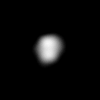 | XIV | Belinda | 40.3 ± 8 | 75,300 | 0.624 | 1986 | Synnott (Voyager 2) | Inner moon | [14][15] | Uranus |
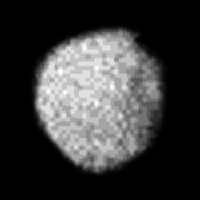 | XV | Puck | 81 ± 2 | 86,000 | 0.762 | 1985 | Synnott (Voyager 2) | Inner moon | [14][15] | Uranus |
| | XVI | Caliban | 49 | 7,231,100 | 579.73 (r) | 1997 | Gladman, Nicholson, Burns, Kavelaars | Retrograde irregular | [14][15] | Uranus |
 | XVII | Sycorax | 75 | 12,179,400 | 1,288.38 (r) | 1997 | Gladman, Nicholson, Burns, Kavelaars | Retrograde irregular | [14][15] | Uranus |
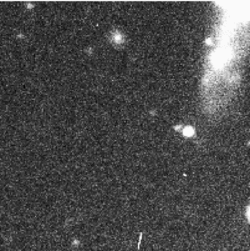 | XVIII | Prospero | 25 | 16,256,000 | 1,978.29 (r) | 1999 | Gladman, Holman, Kavelaars, Petit, Scholl | Retrograde irregular | [14][15] | Uranus |
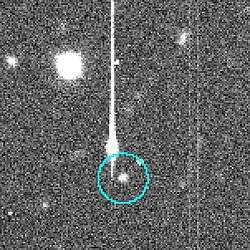 | XIX | Setebos | 24 | 17,418,000 | 2,225.21 (r) | 1999 | Gladman, Holman, Kavelaars, Petit, Scholl | Retrograde irregular | [14][15] | Uranus |
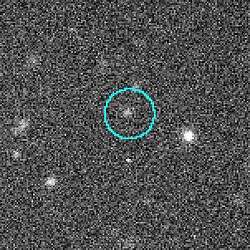 | XX | Stephano | 10 | 8,004,000 | 677.36 (r) | 1999 | Gladman, Holman, Kavelaars, Petit, Scholl | Retrograde irregular | [14][15] | Uranus |
| XXI | Trinculo | 5 | 8,504,000 | 749.24 (r) | 2001 | Holman, Kavelaars, Milisavljevic | Retrograde irregular | [14][15] | Uranus | |
| | XXII | Francisco | 6 | 4,276,000 | 266.56 (r) | 2001 | Holman, Kavelaars, Milisavljevic, Gladman | Retrograde irregular | [14][15] | Uranus |
| XXIII | Margaret | 5.5 | 14,345,000 | 1,687.01 | 2003 | Sheppard, Jewitt | Prograde irregular | [14][15] | Uranus | |
| | XXIV | Ferdinand | 6 | 20,901,000 | 2,887.21 (r) | 2001 | Holman, Kavelaars, Milisavljevic, et al. | Retrograde irregular | [14][15] | Uranus |
| | XXV | Perdita | 10 | 76,417 | 0.638 | 1986 | Karkoschka (Voyager 2) | Inner moon | [15] | Uranus |
| | XXVI | Mab | 5 | 97,736 | 0.923 | 2003 | Showalter, Lissauer | Inner moon | [15] | Uranus |
| | XXVII | Cupid | 5 | 74,392 | 0.613 | 2003 | Showalter, Lissauer | Inner moon | [15] | Uranus |
.jpg) | I | Triton | 1353.4 ± 0.9 | 354,800 | 5.877 (r) | 1846 | Lassell | Retrograde irregular | [14][15] | Neptune |
 | II | Nereid | 170 ± 25 | 5,513,820 | 360.14 | 1949 | Kuiper | Prograde irregular | [14][15] | Neptune |
| | III | Naiad | 33 ± 3 | 48,227 | 0.294 | 1989 | Terrile (Voyager 2) | Inner moon | [14][15] | Neptune |
| | IV | Thalassa | 41 ± 3 | 50,075 | 0.311 | 1989 | Terrile (Voyager 2) | Inner moon | [14][15] | Neptune |
| | V | Despina | 75 ± 3 | 52,526 | 0.335 | 1989 | Synnott (Voyager 2) | Inner moon | [14][15] | Neptune |
 | VI | Galatea | 88 ± 4 | 61,953 | 0.429 | 1989 | Synnott (Voyager 2) | Inner moon | [14][15] | Neptune |
| | VII | Larissa | 97 ± 3 | 73,548 | 0.555 | 1982 | Reitsema, Hubbard, Lebofsky, Tholen (Voyager 2) | Inner moon | [14][15] | Neptune |
.jpg) | VIII | Proteus | 210 ± 7 | 117,647 | 1.122 | 1989 | Synnott (Voyager 2) | Inner moon | [14][15] | Neptune |
| | IX | Halimede | 31 | 15,728,000 | 1,879.71 (r) | 2002 | Holman, Kavelaars, Grav, Fraser, Milisavljevic | Retrograde irregular | [14][15] | Neptune |
| | X | Psamathe | 20 | 46,695,000 | 9,115.91 (r) | 2003 | Jewitt, Kleyna, Sheppard, Holman, Kavelaars | Retrograde irregular | [14][15] | Neptune |
| XI | Sao | 22 | 22,422,000 | 2,914.07 | 2002 | Holman, Kavelaars, Grav, Fraser, Milisavljevic | Prograde irregular | [14][15] | Neptune | |
| XII | Laomedeia | 21 | 23,571,000 | 3,167.85 | 2002 | Holman, Kavelaars, Grav, Fraser, Milisavljevic | Prograde irregular | [14][15] | Neptune | |
| XIII | Neso | 30 | 48,387,000 | 9,373.99 (r) | 2002 | Holman, Kavelaars, Grav, Fraser, Milisavljevic | Retrograde irregular | [14][15] | Neptune | |
| — | S/2004 N 1 | 8–10 | 105,283 | 0.9362 | 2013 | Showalter et al. | Inner moon | [38] | Neptune | |
.jpg) | I | Charon | 603.6 ± 1.4 | 19,591 | 6.387 | 1978 | Christy | [14][15] | Pluto | |
| | II | Nix | 23.0 ± 2 | 48,671 | 24.85 | 2005 | Weaver, Stern, Buie, et al. | [14][15] | Pluto | |
_from_231_000_kilometres.jpg) | III | Hydra | 30.5 ± 4 | 64,698 | 38.20 | 2005 | Weaver, Stern, Buie, et al. | [14][15] | Pluto | |
.jpg) | IV | Kerberos | 14.0 | 57,729 | 32.17 | 2011 | Showalter (Hubble) | [14][15][39][40] | Pluto | |
| | V | Styx | 10.0 | 42,393 | 20.16 | 2012 | Showalter (Hubble) | [14][15][41] | Pluto | |
| I | Hiʻiaka | ~160 | 49,500 ± 400 | 49.12 ± 0.03 | 2005 | Brown et al. | [6][42] | Haumea | ||
| II | Namaka | ~85 | 39,000 (r) | 34.7 ± 0.1 if e = 0 | 2005 | Brown et al. | [6][42] | Haumea | ||
.jpg) | — | S/2015 (136472) 1 | ~80 | 2016 | Parker et al. | [43] | Makemake | |||
 | I | Dysnomia | 257± 110[8] | 37,370 ± 150 | 15.774 ± 0.002 | 2005 | Brown, Rabinowitz, Trujillo et al. | SDO moon | [44][45][46] | Eris |
References
-
 Media related to Natural satellites at Wikimedia Commons
Media related to Natural satellites at Wikimedia Commons
- ↑ Warell, J.; Karlsson, O. (2007). "A search for natural satellites of Mercury". Planetary and Space Science. 55 (14): 2037–2041. Bibcode:2007P&SS...55.2037W. doi:10.1016/j.pss.2007.06.004.
- ↑ "Solar System Exploration: Planets: Venus: Moons". NASA. Retrieved 16 March 2008.
- ↑ Whitehouse, David (21 October 2002). "Earth's little brother found". BBC News. Retrieved 31 March 2007.
- ↑ Sheppard, Scott; et al. (2004). "A Survey for Outer Satellites of Mars: Limits to Completeness". The Astronomical Journal. 128 (5): 2542–2546. arXiv:astro-ph/0409522
 . Bibcode:2004AJ....128.2542S. doi:10.1086/424541.
. Bibcode:2004AJ....128.2542S. doi:10.1086/424541. - ↑ Bieryla, Allyson; Parker, J. W. (December 2006). "Search for Satellites around Ceres". 2007 AAS/AAPT Joint Meeting, American Astronomical Society Meeting 209, #25.02; Bulletin of the American Astronomical Society. 38: 933. Bibcode:2006AAS...209.2502B.
- 1 2 3 Dumas, C.; Carry, B.; Hestroffer, D.; Merlin, F. (2011). "High-contrast observations of (136108) Haumea". Astronomy & Astrophysics. 528: A105. arXiv:1101.2102
 . Bibcode:2011A&A...528A.105D. doi:10.1051/0004-6361/201015011.
. Bibcode:2011A&A...528A.105D. doi:10.1051/0004-6361/201015011. - ↑ M. E. Brown; M. A. van Dam; A. H. Bouchez; et al. (1 March 2006). "Satellites of the Largest Kuiper Belt Objects". The Astrophysical Journal. 639 (1): L43–L46. arXiv:astro-ph/0510029
 . Bibcode:2006ApJ...639L..43B. doi:10.1086/501524.
. Bibcode:2006ApJ...639L..43B. doi:10.1086/501524. - 1 2 Johnston, W. R. (30 December 2008). "(136199) Eris and Dysnomia". Johnston's Archive. Retrieved 2016-12-01.
- ↑ Santos-Sanz, P.; et al. (2012). ""TNOs are Cool": A Survey of the Transneptunian Region IV. Size/albedo characterization of 15 scattered disk and detached objects observed with Herschel Space Observatory-PACS". arXiv:1202.1481
 [astro-ph.EP].
[astro-ph.EP]. - ↑ Daniel W. E. Green (2007-02-22). "IAUC 8812: Sats OF 2003 AZ_84, (50000), (55637), (90482)". International Astronomical Union Circular. Archived from the original on 19 July 2011. Retrieved 2011-07-05.
- 1 2 "Satellites and Companions of Minor Planets". Minor Planet Center. Retrieved 8 January 2011.
- ↑ Wieczorek, M.; et al. (2006). "The constitution and structure of the lunar interior". Reviews in Mineralogy and Geochemistry. 60 (1): 221–364. doi:10.2138/rmg.2006.60.3.
- 1 2 "Notes: The Satellites of Mars". The Observatory. 1 (6): 181–185. 20 September 1877. Bibcode:1877Obs.....1..181. Retrieved 9 March 2008.
- 1 2 3 4 5 6 7 8 9 10 11 12 13 14 15 16 17 18 19 20 21 22 23 24 25 26 27 28 29 30 31 32 33 34 35 36 37 38 39 40 41 42 43 44 45 46 47 48 49 50 51 52 53 54 55 56 57 58 59 60 61 62 63 64 65 66 67 68 69 70 71 72 73 74 75 76 77 78 79 80 81 82 83 84 85 86 87 88 89 90 91 92 93 94 95 96 97 98 99 100 101 102 103 104 105 106 107 108 109 110 111 112 113 114 115 116 117 118 119 120 121 122 123 124 125 126 127 128 129 130 131 132 133 134 135 136 137 138 139 140 141 142 143 144 145 "Planetary Satellite Physical Parameters". JPL, NASA. 19 February 2015. Retrieved 1 February 2016., and references therein.
- 1 2 3 4 5 6 7 8 9 10 11 12 13 14 15 16 17 18 19 20 21 22 23 24 25 26 27 28 29 30 31 32 33 34 35 36 37 38 39 40 41 42 43 44 45 46 47 48 49 50 51 52 53 54 55 56 57 58 59 60 61 62 63 64 65 66 67 68 69 70 71 72 73 74 75 76 77 78 79 80 81 82 83 84 85 86 87 88 89 90 91 92 93 94 95 96 97 98 99 100 101 102 103 104 105 106 107 108 109 110 111 112 113 114 115 116 117 118 119 120 121 122 123 124 125 126 127 128 129 130 131 132 133 134 135 136 137 138 139 140 141 142 143 144 145 146 147 148 149 150 151 152 153 154 155 156 157 158 159 160 161 162 163 164 165 166 167 168 "Planetary Satellite Mean Orbital Parameters". JPL, NASA. 23 August 2013. Retrieved 1 February 2016., and references therein.
- 1 2 3 4 Showman, Adam P.; Malhotra, Renu (1999). "The Galilean Satellites" (PDF). Science. 286 (5437): 77–84. doi:10.1126/science.286.5437.77. PMID 10506564.
- ↑ Barnard, E. E. (1892). "Discovery and Observation of a Fifth Satellite to Jupiter". Astronomical Journal. 12: 81–85. Bibcode:1892AJ.....12...81B. doi:10.1086/101715.
- ↑ Porco, Carolyn C.; et al. (March 2003). "Cassini Imaging of Jupiter's Atmosphere, Satellites, and Rings". Science. 299 (5612): 1541–1547. Bibcode:2003Sci...299.1541P. doi:10.1126/science.1079462. PMID 12624258.
- ↑ Crommelin, A. C. D. (10 March 1905). "Provisional Elements of Jupiter's Satellite VI". Monthly Notices of the Royal Astronomical Society. 65 (5): 524–527. Bibcode:1905MNRAS..65..524C. doi:10.1093/mnras/65.5.524.
- ↑ Perrine, C. D. (1905). "The Seventh Satellite of Jupiter". Publications of the Astronomical Society of the Pacific. 17 (101): 62–63. Bibcode:1905PASP...17...56.. doi:10.1086/121624. JSTOR 40691209.
- ↑ Melotte, P. J. (1908). "Note on the Newly Discovered Eighth Satellite of Jupiter, Photographed at the Royal Observatory, Greenwich". Monthly Notices of the Royal Astronomical Society. 68 (6): 456–457. Bibcode:1908MNRAS..68..456.. doi:10.1093/mnras/68.6.456.
- ↑ Nicholson, S. B. (1914). "Discovery of the Ninth Satellite of Jupiter". Publications of the Astronomical Society of the Pacific. 26: 197–198. Bibcode:1914PASP...26..197N. doi:10.1086/122336.
- 1 2 Nicholson, S.B. (1938). "Two New Satellites of Jupiter". Publications of the Astronomical Society of the Pacific. 50: 292–293. Bibcode:1938PASP...50..292N. doi:10.1086/124963.
- ↑ Nicholson, S. B. (1951). "An unidentified object near Jupiter, probably a new satellite". Publications of the Astronomical Society of the Pacific. 63 (375): 297–299. Bibcode:1951PASP...63..297N. doi:10.1086/126402.
- ↑ Kowal, C. T.; Aksnes, K.; Marsden, B. G.; Roemer, E. (1974). "Thirteenth satellite of Jupiter". Astronomical Journal. 80: 460–464. Bibcode:1975AJ.....80..460K. doi:10.1086/111766.
- ↑ Synnott, S.P. (1980). "1979J2: The Discovery of a Previously Unknown Jovian Satellite". Science. 210 (4471): 786–788. Bibcode:1980Sci...210..786S. doi:10.1126/science.210.4471.786. ISSN 0036-8075. JSTOR 1684562. PMID 17739548.
- ↑ Jewitt, D. C.; Danielson, G.E.; Synnott, S.P. (1979). "Discovery of a New Jupiter Satellite". Science. 206 (4421): 951. Bibcode:1979Sci...206..951J. doi:10.1126/science.206.4421.951. ISSN 0036-8075. JSTOR 1749286. PMID 17733911.
- ↑ Synnott, S.P. (1981). "1979J3: Discovery of a Previously Unknown Satellite of Jupiter". Science. 212 (4501): 1392. Bibcode:1981Sci...212.1392S. doi:10.1126/science.212.4501.1392. ISSN 0036-8075. JSTOR 1686790. PMID 17746259.
- ↑ "IAUC 7460: S/1999 J 1". 20 July 2000. Retrieved 8 January 2011.
- ↑ "IAUC 2845: Probable New Satellite of Jupiter". 3 October 1975. Retrieved 8 January 2011.
- ↑ "IAUC 7525: S/1975 J 1 = S/2000 J 1". 25 November 2000. Retrieved 8 January 2011.
- 1 2 3 4 5 6 7 8 9 "IAUC 7555: Satellites of Jupiter". 5 January 2001. Retrieved 8 January 2011.
- 1 2 3 4 5 6 7 8 9 10 11 12 "IAUC 7900: Satellites of Jupiter". 16 May 2002. Retrieved 8 January 2011.
- 1 2 3 4 5 Jupiter's Known Satellites
- ↑ C. Porco & the Cassini Imaging Team (18 July 2007). "S/ 2007 S 4". International Astronomical Union Circulars. 8857.
- ↑ "IAU Circular No. 9023". International Astronomical Union. 2009. Retrieved 6 March 2009.
- ↑ "IAU Circular No. 9091". International Astronomical Union. 2009. Retrieved 17 January 2010.
- ↑ Kelly Beatty (15 July 2013). "Neptune's Newest Moon". Sky & Telescope. Retrieved 15 July 2013.
- ↑ Showalter, M. R.; Hamilton, D. P. (20 July 2011). "New Satellite of (134340) Pluto: S/2011 (134340) 1". Central Bureau for Astronomical Telegrams. Central Bureau for Astronomical Telegrams. Retrieved 20 July 2011.
- ↑ "NASA's Hubble Discovers Another Moon Around Pluto". NASA. Retrieved 21 July 2011.
- ↑ "Hubble Discovers a Fifth Moon Orbiting Pluto". NASA. Retrieved 13 July 2012.
- 1 2 D. C. Fabrycky; M. J. Holman; D. Ragozzine; M. E. Brown; T. A. Lister; D. M. Terndrup; J. Djordjevic; E. F. Young; L. A. Young; R. R. Howell. "Mutual Events of 2003 EL61 and its Inner Satellite". AAS DPS conference 2008. Retrieved 17 October 2008.
- ↑ "Hubble Discovers Moon Orbiting the Dwarf Planet Makemake". hubblesite.org. 2016. Retrieved 27 April 2016.
- ↑ Brown, Michael E.; Schaller, Emily L. (15 June 2007). "The Mass of Dwarf Planet Eris". Science. 316 (5831): 1585. Bibcode:2007Sci...316.1585B. doi:10.1126/science.1139415. PMID 17569855. (Including Supporting Online Material 25 March 2016. VOL 351, ISSUE 6280, PAGES 1371-1494.)
- ↑ "Dwarf Planet Outweighs Pluto". space.com. 2007. Retrieved 14 June 2007.
- ↑ Brown, M. E.; Van Dam, M. A.; Bouchez, A. H.; Le Mignant, D.; Campbell, R. D.; Chin, J. C. Y.; Conrad, A.; Hartman, S. K.; Johansson, E. M.; Lafon, R. E.; Rabinowitz, D. L. Rabinowitz; Stomski, P. J., Jr.; Summers, D. M.; Trujillo, C. A.; Wizinowich, P. L. (2006). "Satellites of the Largest Kuiper Belt Objects" (PDF). The Astrophysical Journal. 639 (1): L43–L46. arXiv:astro-ph/0510029
 . Bibcode:2006ApJ...639L..43B. doi:10.1086/501524. Retrieved 2011-10-19.
. Bibcode:2006ApJ...639L..43B. doi:10.1086/501524. Retrieved 2011-10-19.
